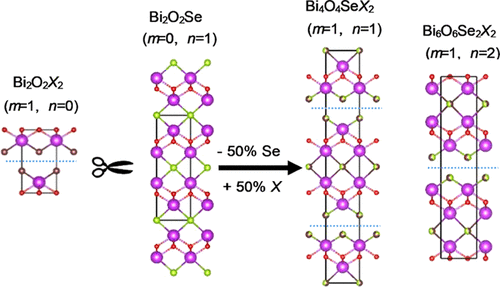Ask for a reprint
email :
* Give your email
2022
ACL
|
R.Ji, M.Lei, C.Genevois, W.Zhang, X.Ming, L.He, M.Allix*, C.Yin*, X.Kuang*, X.Xing, 'Multiple Anion Chemistry for Ionic Layer Thickness Tailoring in Bi2+2nO2+2nSenX2 (X = Cl, Br) van der Waals Semiconductors with Low Thermal Conductivities', Chem. Mat. 34 4751-4764 (2022) doi:10.1021/acs.chemmater.2c00786
Layered materials coupling a two-dimensional strong-bonding layered network with much weaker van der Waals (vdW) interaction between the layers are sought after for the development of nanoelectronics and energy conversion devices. It is important to elucidate the layer stacking rules in these vdW materials and control the thickness of the strong-bonding layers for tuning the nanosheet height during exfoliation and therefore tailor physical properties. Here, we show that the single Bi2O2Se ionic layer in the three-anion vdW semiconductor Bi4O4SeCl2 showing extremely low thermal conductivity can be expanded to higher-order layers forming a homologous series Bi2+2nO2+2nSenX2 (X = Cl, Br) with variable ionic layer thicknesses. Bi4O4SeX2 (n = 1) and Bi6O6Se2X2 (n = 2) were isolated as single-phase materials, while materials with larger layer thicknesses such as Bi8O8Se3Cl2 (n = 3) contain different defect-intergrowth structures at the crystallite scale. The anionic disorder of Se and X within the Bi2O2Se and Bi2O2X2 slabs is a critical factor in the stabilization of Bi2+2nO2+2nSenX2. The ∼50% Se substitution by X anions in the Bi2O2Se slab as related to the weak interlayer interaction can serve as a stabilization criterion of Bi2+2nO2+2nSenX2. All of these materials show similar optical indirect band gaps of ∼1.05 eV, originating from the electronic states in the Bi2O2Se slabs. Pellets prepared from these vdW materials possessed low bulk resistivities (100 Ω·cm) and exceptionally low and tunable thermal conductivities (0.66 W/mK and lower) parallel to the pressing axis of the pellets (heavier the halogen is, lower is the thermal conductivity). The results presented here provide important multiple anion chemistry for tailoring the ionic-bonding network into different thicknesses in the vdW layered structures and therefore their physical properties.
|

|